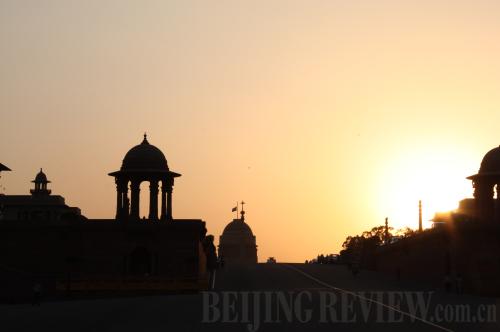|
 |
|
AT DUSK: The central government office area at dusk (LU ANQI) |
Shanghai & Mumbai
Those who are comparing the two countries often align Mumbai with Shanghai, and call Mumbai "India's Shanghai." Though the analogy may not be proper, it highlights the characteristics of the two cities and their respective positions in each country.
To some extent, the growth and development speed of the two cities, which share similar historical backgrounds, also reflect the development mode and speed of each country as a whole.
With a population of 23.03 million, Shanghai is the largest city in China, and with 13 million in its urban area, Mumbai is the largest city in India. Shanghai is a large port on China's east coast facing the Pacific; while Mumbai is a large port on the west coast of India facing the Arabian Sea and Indian Ocean. Shanghai is China's premier economic, scientific, technological, industrial, financial, trade, convention and exhibition, and shipping center, boasting the largest harbor and industrial base in the country. Mumbai, likewise, serves as an industrial hub, and is known as the commercial and financial capital of India.
They share much in common, but as far as differences are concerned, the most glaring may be infrastructure. The Oscar-winning film Slumdog Millionaire awed viewers by revealing massive shanty towns on the outskirts of the city. The majority of Mumbai people I met asserted the major difference between Mumbai and Shanghai is that their city lacks world-class municipal infrastructure. In fact, Shanghai also leads China in municipal infrastructure construction. It has long been one of the city's particular strengths. In the mid-1990s, Shanghai started building cloverleaf overpasses to ensure a fast and smooth traffic in the city. About ten years ago, its maglev trains began operating, covering the 30 kilometers between Pudong International Airport and downtown in only eight minutes.
Some of my Chinese counterparts and Indian friends tend to compare the current situation in Mumbai or even in India as a whole to that of China in the 1970s or 1980s. I don't know what exactly this assertion is based on. The diversity of Indian society has created a complex social structure. While it may reach international standards for modernity, in other ways it seems to remain in the past.
For instance, on Mumbai streets one will find at least four types of taxis which vary in appearance and quality. The most modest, or oldest type, is the three-wheeled motor vehicle that charges 14 rupees ($0.25) for the first three kilometers, and seven rupees per kilometer thereafter. The most luxurious taxis were Toyota cars painted with colorful ads. The busy Mumbai streets are a symphony of varying taxis, trucks colorfully painted with traditional patterns, Honda motorbikes, domestic Tata cars and various newer Japanese cars.
If you think the Slumdog Millionaire portrayed the whole city accurately, think again. In fact, Mumbai's airport is ranked third globally among the airports handling 25 to 40 million passengers annually. It also features eight-lane cable bridges and boutiques. There is much new construction, such as elevated expressways and cloverleaves, and at Mumbai Railway Station, there was nothing evocative of the familiar images of green carriages brimming with passengers. Instead, they resembled China's modern high-speed trains. We couldn't hide our disappointment. "Are you sure you really want to see that situation?" our guide asked with a grin.
With the increase of political, economic and cultural exchanges between China and India, as well as increasing exchange between people of the two countries, comparisons of cities across the border can provide a meaningful starting point for mutual understanding. |
